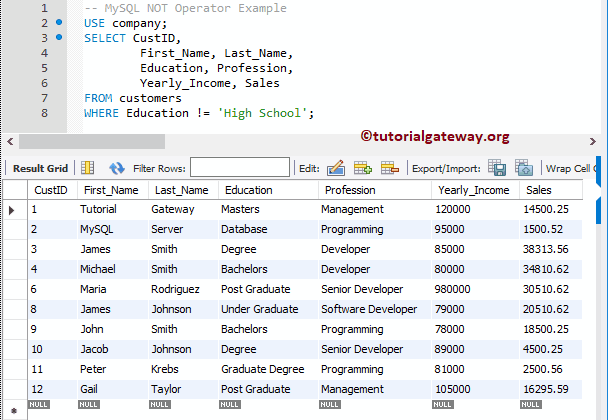SQL WHERE condition, not equal to? MySQL where NOT IN name array? ISNULL( expr ) If expr is NULL , ISNULL() returns , otherwise it returns 0. You can combine the IN operator with the NOT operator to determine if a value does not match any value in a list or a subquery. And you can also use the IN operator in the WHERE clause of other statements such as UPDATE, and DELETE.
Let’s practice with some examples of using the IN operator. If expression is NOT a NULL value, the condition evaluates to TRUE. Example - With SELECT Statement. Syntax: If expr is not greater than or equal to min and expr is not less than or equal to max, BETWEEN returns otherwise, it returns 0. Returns (TRUE) or (FALSE). If either expr or pat is NULL, the result is NULL.
The pattern need not be a literal string. For the preceding example, if tcontains any rows, even rows with nothing but NULL values, the EXISTS condition is TRUE. Tests whether a value is not NULL. It is used to negate a condition in a SELECT, INSERT, UPDATE or DELETE statement. The first plan is from the NOT IN query, the second is from the NOT EXISTS.
Almost identical: both select rows from the USERS table, and then use a nested-loops join (“dependent subqueryrquo;) to retrieve rows from the EVENTS table. Both claim to use EVENTS_USER_IDX to select rows in the subquery. The SQL AN OR and NOT Operators. The AND and OR operators are used to filter records based on more than one condition: The AND operator displays a record if all the conditions separated by AND is TRUE.
The NOT operator displays a record if the condition (s) is NOT TRUE. This means EXCEPT returns only rows, which are not available in the second SELECT statement. This is not harmful to SELECT queries using subqueries in its WHERE clause. This does affect DELETE and UPDATE queries with such a WHERE clause.
In that instance, it is much better to decompose the query into separate steps. Just as with the UNION operator, the same rules apply when using the EXCEPT operator. The basic syntax of EXCEPT is as follows. The search_condition is a combination of one or more predicates using the logical operator AN OR and NOT. Any row from the table_name that causes the search_condition to evaluate to TRUE will be included in the final result set.
Content reproduced on this site is the property of the respective copyright holders. It is not reviewed in advance by Oracle and does not necessarily represent the opinion of Oracle or any other party. Speeding up a NOT IN subquery. Based upon this i have a state-table for user dependent states of an item.
Currently, the user-state-entry will only be generate if the item was read or saved the first tim. Otherwise, there is no entry in the user_item table. In the beginning, this query was fine but now, it takes a lot of time.
The underscore wildcard is used to match exactly one character. I am using Start Command Prompt with Ruby on Windows 8. Treehouse Moderator 26Points. Using NOT IN with a subquery. The following example finds the salespersons who do not have a quota greater than $25000.

NOT IN finds the salespersons who do not match the items in the values list. Uses AdventureWorks SELECT p. Person AS p JOIN Sales. This example would return all rows from the products table where the product_name is not Pear, Banana or Bread.
Sometimes, it is more efficient to list the values that you do not want, as opposed to the values that you do want. SQL HOME SQL Intro SQL Syntax SQL Select SQL Select Distinct SQL Where SQL An Or, Not SQL Order By SQL Insert Into SQL Null Values SQL Update SQL Delete SQL Select Top SQL Min and Max SQL Count, Avg, Sum SQL Like SQL Wildcards SQL In SQL Between SQL Aliases SQL Joins SQL Inner Join SQL Left Join SQL Right Join SQL Full Join SQL Self Join SQL.
Geen opmerkingen:
Een reactie posten
Opmerking: Alleen leden van deze blog kunnen een reactie posten.